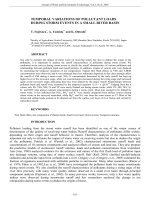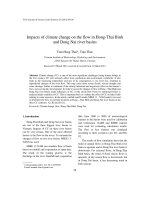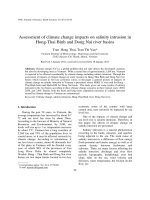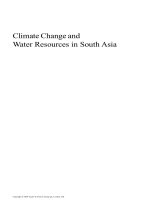Assessment of climate change impacts onwater resources in Hong-Thai Binh river basin
Bạn đang xem bản rút gọn của tài liệu. Xem và tải ngay bản đầy đủ của tài liệu tại đây (1.25 MB, 8 trang )
<span class='text_page_counter'>(1)</span><div class='page_container' data-page=1>
VNU Journal of Science, E arth Sciences 26 (2010) 202-209
<b>Assessment o f climate change impacts on water resources </b>
<b>in Hong-Thai Binh river basin</b>
<b>Tran Hong Thai*</b>
<i><b>V ietnam In stitu te o f M e te o r o lo g y , H y d r o lo g y a n d E n viro n m en t,</b></i>
<i><b>2 3 /6 2 N g u yen C h i Thanh, H anoi, Vietnam</b></i>
Received 12 November 2010; received m revised form 26 November 2010
Abstract. Rapid socio-economic development <b>leads </b>to a <b>great increase </b>in <b>water demand </b>of <b>many </b>
sectors and conflicts between water users. Moreover, studies have warned about serious degree of
influence of climate change (CC) on Vietnam, particularly on the water resources. Therefore,
assess c c impacts on water balances are very necessary task. The Ministry of Natural Resources
<b>and E n v ứ o n m en í has co m p leted the appro p riate clim ate change scenarios in V ietn am [1]. In this </b>
study, water balance results will be presented including three scenarios: high emissions scenario
(A2), medium emission scenario (B2), and low emission scenario (Bl). The water balanced in
Hong-Thai Binh river basin was calculated, which is one of the largest <b>basins </b>in Vietnam. The
basin is very complicated: Under the ũưiuence of flow regime of international rivers [2], a system
<b>o f reservoừs and ÚTÌgation sữuctures </b>serving <b>diverse purposes, such as o f water supply, irrigation, </b>
flood conứol and hydropower [3-5]. MIKE BASIN model was applied to describe exploitation,
utilization and to identify ứie water shortage areas according to ứie climate change scenarios.
<i><b>Keywfords: climate change, water resources, Hong-Thai Binh river.</b></i>
<b>i. Introduction about the study area</b>
Hong-Thai Binh river basin is an
international river basin that flows through
three countries: Q iina, Laos, Vietnam with a
total nahiral area is 169,000 km^ The area of
basin located in Vietnam is: 86,680 km^,
occupying 51.3% o f the total.
This is the second largest river basin, (after
ứie Mekong basin) in Vietoam which flows into
East sea. Hong-Thai Binh river is formed from
6 major tributaries: Da, Thao, Lo, Cau, Thuong
and Luc Nam rivers.
Tel: 84-4-38359491
E-maii: tranứì
Pigiưe 1. Topographic map of Hong-Thai Binh
river basm.
</div>
<span class='text_page_counter'>(2)</span><div class='page_container' data-page=2>
<i>T.H. Thai / V N U journal o f Science, Earth Sciences 26 (2010) 202-209</i> <sub>203</sub>
<b>2. Research method</b>
In this study, two methods were used as
follows;
<i>(ij Document synthesis and data analysis;</i>
<i>and</i>
<i>(ii) Mathematical model.</i>
MDCE BASD^i model was used to calculate
water balance in Hong-Thai Binh river basin,
where MIKE NAM model was also used for
inflow calculation in this basin.
MIKE BASIN is a tool for water resources
management, and more exactly it is a tool to
calculate the optimal balance between water
demand and available water amount. It supports
the managers in choosing suitable development
scenarios, exploitation and protection o f water
resources in the future.
<b>3. Application of MIKE BASIN model to </b>
<b>calculate the water balance in Hong-Thai </b>
<b>Binh river basin</b>
<i>3.1. Water balance scheme and irrigation system</i>
Based on characteristics o f the basin such
as: topography, climate, inigation systems, and
distribution o f population, the river basin was
divided into six sub-basins (Da, Thao, Lo, Cau,
Nhue-Day, downsứeam Hong-Thai Binh River)
including 91 sub-areas.
The simulated irrigation system in MIKE
BASIN model are: reservoirs and hydro-powers
parameters o f which are: reservoirs relationship
(Z ~ F ~ V), reservoir water level, capacity of
hydro-plants, reservoir water level changes,
regulation o f reservoir operation.
Baseline and scenario simulation: 25
reservoirs and five hydroelectric powers.
</div>
<span class='text_page_counter'>(3)</span><div class='page_container' data-page=3>
204 <i>T.H. Thai / VN U Journal o f Science, Earth Sciences 26 (20Ĩ0) 202-209</i>
<b>Table 1. The parameters o f hydropowers in the Hong-Thai Binh river basin.</b>
<b>Nam o f </b>
<b>hydropower</b>
<b>Year </b>
<b>o f beginning</b>
<b>Year </b>
<b>o f operation</b>
<b>Install capacity </b>
<b>(M W )</b>
<b>Energy </b>
<b>production </b>
<b>(10^ KWh)</b>
<b>Function</b>
<b>Lai Chau </b>
<b>Son La</b>
<b>Hoa Binh </b>
<b>Tuyen Quang </b>
<b>%</b>
<b>Thac Ba</b>
2010
<b>2005</b>
<b>1979</b>
2002
<b>1961</b>
<b>2017</b>
2012
<b>1994</b>
<b>2008</b>
<b>1971</b>
1200
<b>2400</b>
<b>1920</b>
<b>342</b>
120
<b>4 7 0 0</b>
<b>10246</b>
8160
<b>1329</b>
<b>414</b>
<b>Electricity generation </b>
<b>E lecừ icity generation </b>
<b>Flood conưol </b>
<b>Iưigation </b>
<b>E lecừ icity generation </b>
<b>Flood conứol </b>
<b>Electricity generation </b>
<b>Flood conữol </b>
<b>lư igation </b>
<b>Generate electricity</b>
<i>3.2. Input data</i>
<i><b>3.2.1. Inflow</b></i>
Inflows in the hydro stations and on the
sub-basins were calculated according to three
climate change scenarios A2, B l, B2 for the
following periods: baseline (1980-1999), 2020-
2039, 2040-2059, 2060-2079, and 2080-2099.
MIKE NAM model was used to calculate
the inflow according to three climate change
scenarios A2, B l, B2. The total annual flow
in c re a s e s s lig h tly in a ll th e t h r e e icenario< ;
However, variation rates o f annual flow in each
ưibutary are not different.
<i><b>3.2.2. Water demand</b></i>
On the basin, water demand was calculated
in Hong-Thai Binh: agriculture, aquaculture,
indusừy, domestic sector, public services and
tourism. To assess the influence o f climate
change on water demand two Cases were
considered.
Due to limitations o f published data, the
water requirement o f livestock, industry,
aquaculture, domestic sector, public services
and tourism were calculated to 2020 according
to the Statistical Year Book 2000 (Case 1) and
the planning o f socio-economic development
plan to 2020 o f provinces in the basin (Case 2),
with the assumption that these demands would
not be changed by 2100. This means there is
only water demand for the main user
(agriculture) that will be changed throughout
the periods. For each Case, the water demand
for agriculture was calculated for 20 years from
1980 to 2000 and for 80 years from 2020 to
2100 with the assumption that agricultural area
and cultivated crop structure were constant.
Thus, the changes o f water demand for
agricultiưe only would depend on precipitation
and evaporation.
<i><b>Case I (W Dl): Calculation of water </b></i>
demand for the periods 1980-1999 and 2020-
2100 based on the Statistical Year Book 2000
for the data on agricultural and industrial areas,
livestock, population and the data o f rainfall
and temperature scenarios for projected
agricultural demand.
<i><b>Case 2 (WD2): Calculation o f water </b></i>
</div>
<span class='text_page_counter'>(4)</span><div class='page_container' data-page=4>
<i>T.H. Thai / V N U Ịo u rm l of Science, Earth Sciences 26 (2010) 202-209</i> 205
<b>(a) Water demand - C ase 1 </b> <b>(b) Water demand - Case 2</b>
<b>Figure 3. The trend o f water demand in the 2 Cases.</b>
<i>3.3. Choosmg option fo r water balance calculation</i>
In order to calculate water balance on
Hong-Thai Binh river basin, the options were
chosen based on (i) the planning o f socio
economic development o f the region, o f each
provinces and o f each sector [4,6,7]; (ii) climate
<b>Table 2. Options for water balance calculation.</b>
change scenarios [1], The main criteria
considered choosing option were; (i) inflow, (ii)
water demand, (iii) irrigation system. The
options for water balance calculation are shown
in Table 2.
<b>W ater balance</b> c c <b>System o f w ater resources</b> <b>Water</b> <sub>Inflow</sub>
<b>(WB) Cases</b> <b>scenarios</b> <b>structures</b> <b>demand</b>
A2 <b>W D l - A2</b> A2
<b>WB - Case 1</b> <b>B2</b> <b>W D l - B 2</b> B2
B1 <b>W D l - B 1</b> Đ1
A2 <i><b>Au reservoirs, 3 nyoropowvr piaiiis</b></i> <b>W D2 - A2</b> A2
WB <b>- Case 2</b> <b>B2</b> <b>W D2 - B2</b> <b>B2</b>
<b>Đ1</b> <b>W D 2 - B I</b> B1
<b>4. Results and discussion</b>
<i>4.1. Water balance results</i>
According to calculation results, water
shortage in the sub-basins and the whole basin
more and more increase. Total o f water demand
in ứie Case 2 is bigger approximately 5 billion
m’ per year than that in Case 1. In addition,
because inflows in both Cases are constant, so
water shortage in Case 2 is 4.2 to 4.8 billion
per year, occupying 15% -17% o f water
demand in the whole basin. There are no
differences between two Cases in terms of
quantity and percentage o f water deficit. Trend
o f water shortage in Da, Thao, Lo, Cau Thuong,
Luc Nam, Nhue, Day basins and the
</div>
<span class='text_page_counter'>(5)</span><div class='page_container' data-page=5>
206 <i>T.H. Thai Ị V N U Journal o f Science, Earth Sciences 26 (20Ĩ0) 202-209</i>
<b>10*m*/year</b>
<b>Figure 4. Water shortage in the w hole region under three scenarios- W B Case 1</b>
<b>Figure 5. Water shortage in the w hole region under three scenarios - W B Case 2. </b>
<b>Table 3. The total average water shortage in period- W B C ase 1.</b>
<b>Scenario</b>
<b>1980-1999</b> <b>2020-2039</b> <b>2040-2059</b> <b>2060-2079</b> <b>2080-2099</b>
<b>'^didclt</b> <b>Vdificie</b> <b>Vdttlcll</b> <b>Vdiflcit</b>
<b>B1</b> <b>3,241.1</b> <b>3,347.8</b> <b>3,412.0</b> <b>3,445.6</b> <b>3,455.9</b>
<b>B2</b> <b>3,241.1</b> <b>3,338.1</b> <b>3,420.1</b> <b>3,478.7</b> <b>3,524.5 </b> <b>■</b>
<b>A2</b> <b>3,241.1</b> <b>3,339.1</b> <b>3,418.2</b> <b>3,497.8</b> <b>3,564.6</b>
</div>
<span class='text_page_counter'>(6)</span><div class='page_container' data-page=6>
<i>T.H. Thai / V N U Journal ofScitnce, Earth Sciences 26 (2010) 202-209</i>
T ab le 4. T he total average w ater shortage p eriod - W B C ase 2.
207
<b>S cen a rio</b>
<b>19 8 0 -1 9 9 9</b> <b>2 02 0-20 39</b> <b>2040-2 059</b> <b>2 06 0-20 79</b> <b>2080-2 099</b>
<b>Vdeficil</b> <b>Vdtficil</b> <b>Vdificit</b> <b>Vdeficil</b> <b>^deficit</b>
<b>B1</b> <b><sub>4 ,2 2 0 .6</sub></b> <b><sub>4,492.8</sub></b> <b><sub>4,575.2</sub></b> <b><sub>4,6 1 9 .0</sub></b> <b><sub>4,663.3</sub></b>
<b>B2</b> <b><sub>4 ,2 2 0 .6</sub></b> <b><sub>4,49 3.9</sub></b> <b><sub>4,599.8</sub></b> <b><sub>4,6 7 7 .6</sub></b> <b><sub>4,7 59 .9</sub></b>
<b>A2</b> <b><sub>4 ,2 2 0 .6</sub></b> <b><sub>4,49 4.4</sub></b> <b><sub>4,595.2</sub></b> <b><sub>4,6 9 9 .0</sub></b> <b><sub>4,8 01 .2</sub></b>
<i><b>(Unit: I l f </b></i> <i><b>/ y e a r )</b></i>
<i>4.2. Energy production</i>
The calculation result shows that the
average monthly energy production of
hydropower plants during the dry season has a
decreasing tendency and in flood season has
increasing tendency in comparison with the
baseline scenario. For all hydropower plants,
annual energy production is on the increase in
the periods 1980-1999, 2020-2039, 2040-2059,
2060-2079, and 2080-2099. However, this
change is not significant.
M W
<b>M W</b>
■ 2500
<b>1</b>
Ị 2000
1500
1000
500
0 J
Sơn Lj-A2
- • - 1980-1999
-^2020-2039
-•-2040-2059
2060-2079
->-2080-2099
</div>
<span class='text_page_counter'>(7)</span><div class='page_container' data-page=7>
208 <i>T.H. Thai f V N U Ịonrnaí of Science, Earth Sciences 26 (20Ĩ0) 202-209</i>
M W <b>Year</b>
1980-2000 2020-2039 2040-2059 2060-2079 2080-21ŨŨ
<b>Period</b>
<b>Case 2</b>
<b>Figure 7. Annual energy production o f Son La hydropower plant under 3 scenarios.</b>
<b>5. Conclusions</b>
1) Climate change causes the increase in the
total annual the whole basin. The inflow
increases in flood season and decreases in dry
season, which would influence on water
balaiicc in llỉe basin. The increase temperature
causes increase in evaporation, while rainfall
decreases in the dry season, therefore water
demand is higher and higher, so water shortage
is more and more seriously.
2) According to the forecast, the water
demand in the period 2020 to 2100 from 21.52
to 22.54 billion per year for Case 1 and from
27.17 to 28.19 billion per year for Case 2
can be met.
3) In general, annual energy production is
on the increase in the periods as compared to
<i><b>the baseline. However, this change is not </b></i>
significant.
4) In the context o f climate change, under
unfavorable conditions for water use and, water
allocation and use become extremely difficult
and complicated. If some reservoirs were built
in the upsữeam in the future, it would influence
on the capacity o f meeting the water demand in
downstream. Therefore it needs to pay attention
to reservoir operation especially cascade
operation, regulating water resources use to
meet water demand in the future.
<b>Acknowledgments</b>
The author acknowledges the financial
support by Danish International Development
Agency (DANIDA) for the project "Impacts of
climate change on water resources and
adaptation measures".
<b>References</b>
<b>[1] Ministry o f Natural Resources and Environment, </b>
<i><b>Climate change, sea level rise scenarios for </b></i>
</div>
<span class='text_page_counter'>(8)</span><div class='page_container' data-page=8>
<i>T.H. Thai / VN U Journa! o f Science, Earth Sciences 26 (2070) 202-209</i> <i>2 0 9</i>
<i><b>[2] Tran 'rhanh Xuan, H ydrological features and </b></i>
<i><b>water resources in Vietnam rivers, Agriculture </b></i>
<b>publishing house, 2007 (In Vietnamese).</b>
<b>[3] Water </b> <b>Resources </b> <b>University, </b> <i><b>Research </b></i> <i><b>on </b></i>
<i><b>scientific and p ractical bases f o r w ater supply in </b></i>
<i><b>the dry season f o r the Hong River Deỉtùy 2007 (In </b></i>
<b>Vietnamese).</b>
<i><b>[4] Water Resources Planning Institute, The synthetic </b></i>
<i><b>use o f water resources in Hong - Thai Binh River^ </b></i>
<b>2005 (In Vietnamese).</b>
<i><b>[5] W ater Resources Planning Institute, Developing </b></i>
<i><b>operating regulation f o r cascade in Da and Lo </b></i>
<i><b>Rivers in the dry season f o r downstream o f Hong- </b></i>
<i><b>Thai Binh River, 2007 (In Vietnamese).</b></i>
<i><b>[6] General Statistic Office, Socio-Economic Statistic </b></i>
<i><b>Data o f 671 districts, towns and cities belong to </b></i>
<i><b>authority o f provinces in Vietnam^</b></i> Statistical
<b>Publishing House, 2006.</b>
</div>
<!--links-->









